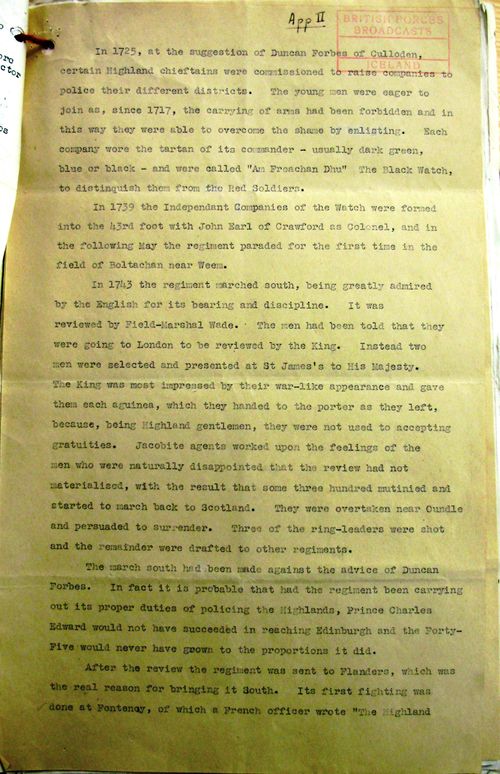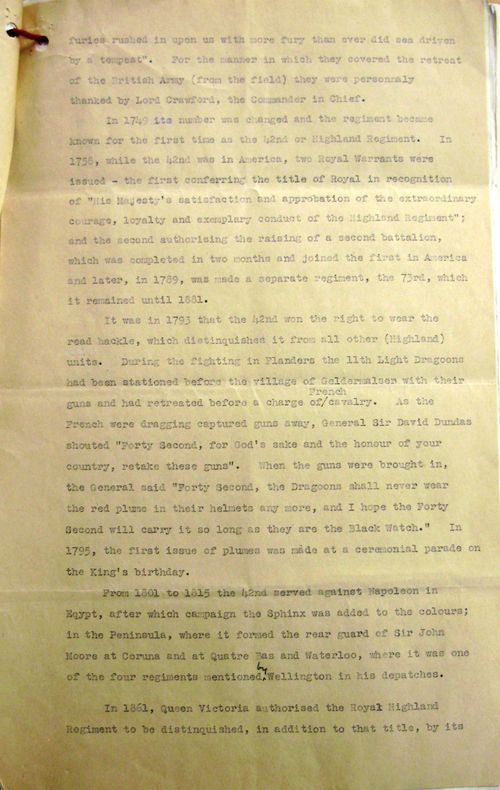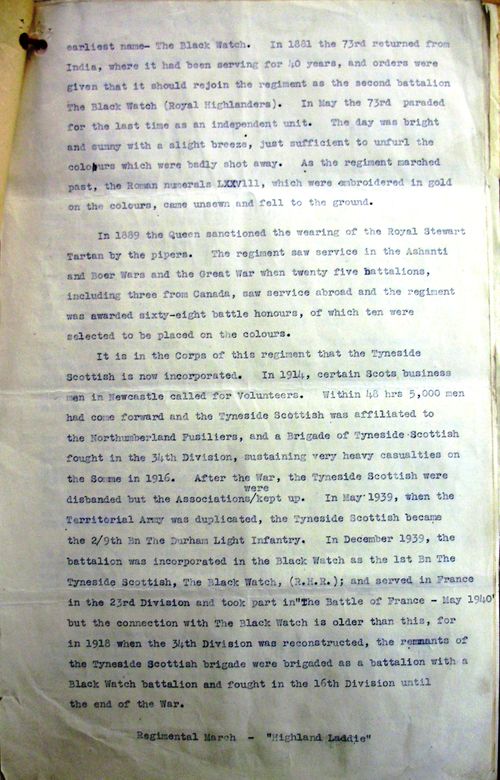1st Tyneside Scottish December 1941
2nd December 1941 Hafnafjordur.
The fifteenth Leave Party returned from the UK.
4th December 1941
The seventeenth Leave Party left for the UK.
5th December 1941
An administrative inspection was carried out by the Brigade Commander, Brigadier P. Kirkup D.S.O., O.B.E., M.C., T.D. – the Companies inspected being HQ, A, C and R.
6th December 1941
A conference was held at Battalion HQ at which the preliminary instructions for the move to the UK were issued. The documents concerned were attached to the War Diary as Appendix 1 – for details see below.
8th December 1941
The heavy baggage was loaded on to “SS BOLLSTA” at Hafnafjordur.
10th December 1941
A radio broadcast on the Regimental History of the Black Watch and the Tyneside Scottish was given in the “Hour in English” from Reykjavik by 2.Lt J.G. Allan. The transcript of his broadcast was attached to the War Diary as Appendix 2 – for a copy of the transcript - with thanks to The National Archives at Kew for access to the War Diary file - see below.
12th December 1941
The Officers of the Battalion held a farewell dance in the Garrison Recreation Hut at which the guests included; the Brigade Commander, Flag Officer In Command, and representatives of the British and US units in the South West Sector.
15th December 1941
A party of 300 Officers and Men of the unit were addressed by the G.o.C. – Major-General H.O. Curtis C.B., D.S.O., M.C. A transcript of his speech was attached to the War Diary at Appendix 3 – for details see below.
19th December 1941
C Company embarked at Reykjavik on “H.M.T. SOBIESKI”.
20th December 1941
The remainder of the Battalion embarked on “H.M.T. SOBIESKI”, the Hafnafjordur area being taken over by 1st Battalion, 10th Infantry Regiment, US Army. Brigade HQ and 11th DLI also embarked on this ship. Details of the arrangements were set out on Appendix 4 attached to the War Diary – for details see below.
21st December 1941 - AT SEA.
The Battalion sailed from Reykjavik.
A letter was received by Brigadier Kirkup from the G.o.C., complimenting the troops on their work in ICELAND. A copy of the letter was attached to the War Diary at Appendix 5 – for details see below.
23rd December 1941
The Battalion arrived at GOUROCK.
All Officers and Men of the Battalion who had not had leave from ICELAND left for fourteen days’ disembarkation leave.
24th December 1941
The remainder of the Battalion disembarked and entrained for LLANELLY, Carmarthen, South Wales.
25th December 1941 LLANELLY.
The Battalion arrived at LLANELLY where it joined the 16th Leave Party, who had acted as Advance Party. The unit relieved in the location was the 1st Battalion Border Regiment.
The Battalion locations were as follows:-
Battalion HQ and HQ Company (less Mortar, Carrier and Motor Transport Platoons) at the Drill Hall LLANELLY.
A Company at ASHBURNHAM Camp reference 8722 on Map sheet 100.
B Company, R Company and the Mortar Platoon at FURNACE Camp reference 9423.
C Company at PEMBREY Camp reference 8425.
D Company at PENCLAWDD Camp reference 9917.
Motor transport and Carrier Platoons at PEMBREY HOUSE reference 8723.
29th December 1941
The seventeenth Leave Party returned.
31st December 1941
A Leave Party comprising 80% of the Officers and Men at LLANELLY who had disembarked from “H.M.T. SOBIESKI” proceeded on 14 days’ disembarkation leave.
Appendices attached to the December 1941 War Diary of 1st Tyneside Scottish.
Appendix 1 – Relief of the Hafnafjordur Sub-Sector – issued 7th December 1941.
The first document was Administrative Instruction No 1. This was issued in confirmation of the verbal orders given at the previous days’ conference.
2/Lt Maclagan, Sgt Douglas and 20 men of B Company were to report to “SS BOLLSTA” at Hafnafjordur at 08:00 hours on Monday 8th December 1941 to act as the Baggage Party. Loading the estimated 60 tons of baggage was to be completed by 21:00 hours.
Companies were to ensure that all stores, including pianos and “comforts”, but not G1098 equipment, were transported to the docks ready for loading. Items were to be marked with the unit identity number (27476), or suitably labelled, and identified on a delivery note which would be checked, against items loaded on to the vessel, by 2/Lt Maclagan, with copies kept by both himself and the Company. The items would be colour-coded with paint in a set of coloured bars – red/buff/red plus a Company colour.
All weapons and the appropriate scale of ammunition were to be retained for loading on to the troopship, together with enough cooking equipment for the unit to maintain itself after landing – the rest being included with the heavy baggage. The baggage would also include any items which could be temporarily “done without” – such as; surplus G1098 equipment, kit of men on leave or at Training Schools and the Band instruments (except for Pipes and Drums).
The dress for the move was Field Service Marching Order over greatcoats. Men’s personal clothing, sleeping bags and blankets were to be taken on the troopship, allowing for some items to be bundled on a section basis, such as gumboots. For the purposes of the move the Reconnaissance Platoon would be administered by R Company, and the Medical Detachment and No 3 Platoon by HQ Company.
Personnel due to attend Training Schools in Iceland would form the Rear Party, attached to 10th DLI until the conclusion of their courses.
Accommodation stores would be handed over on relief and any barrack damages would be rectified before handover if at all possible. A nominal role of those embarking was to be produced (sadly these have not survived in the War Diary).
Appendix 2 – The History of the Black Watch and the Tyneside Scottish – transcript of radio broadcast (with an acknowledgement to The National Archives).
Appendix 3 – Address by Major-General Curtis – 15th December 1941.
“I just thought that I would come along this morning to say “Good-bye” to you all. I hope I shall be with you again at not too an advanced date.
Now, I just wanted to say how much not only I appreciated, but also higher authorities, all the work that you have done since you have been in Iceland. It is very much appreciated by the RAF and by the Prime Minister himself and the Government – the enormous amount of work that the troops have put in, especially on the aerodrome, which has had such an effect on the Battle of the Atlantic, the casualties in which have been kept down by the aircraft being able to fly day and night. Not only have they sunk many submarines but they have had a great effect on the submarines’ morale, and in the protection of the convoys. The route from America past Iceland to Great Britain is absolutely vital. It is our jugular vein by which people are fed, by which the aeroplanes are taken and by which all the ammunition and other warlike stores we require come past Iceland. The other thing is the keenness always displayed by you on training, and, although you have had a long wait, our time will come when every minute of that training will tell.
Now, you may know that the Division has been given special tasks. Not only are we expected to be able to take on any task of an ordinary Division, but the authorities intend to make use of our special experience in Iceland in snow and mountain conditions. So, we have these three roles – to be able to fight anywhere at any time like any other Division, and to maintain ourselves in the difficult conditions of snow and mountain.
Now that is the task that faces you – the first Brigade to go. You will find that you will go to a selected area where there are selected troops to train with and to get on with this task which I have just mentioned. You will have the full facilities for doing that better than if you were actually in the Reykjavik area. And the others will be carrying on, and have already started to do so in the North, the same sort of training. And I know that when I come and see you again at the other end, I shall find the training well advanced and setting a good example, so that the Division will be ready to be sent anywhere the High Command wishes to use it.
Well, I wish you the best of luck on the voyage. I hope it will be a great deal smoother than it has been for me during the last fortnight and I wish you a very happy Christmas. And those of you who have not had leave, I hope you will have the chance of seeing your people without much delay.
The best of luck in 1942.”
In conversation with Colonel Oxley afterwards, General Curtis made special reference to the high standard of discipline that had been displayed by the troops during their stay in Iceland, and commented that it was apparent that they all realised their responsibilities as representatives of Britain in this country.
Appendix 4 – Relief of Hafnafjordur Sub-Sector – issued 11th December 1941.
This included Administrative Instruction No 3, issued in conjunction with Operation Instruction No 1, and dealt with further details of the loading of the troopship “SOBIESKI”.
Lt Col Oxley was to be OC troops on board, with Captain Keith, and then Captain Boyne, as ship’s Adjutant. RSM W.W. Williams would be ship’s Sergeant-Major. 2/Lt Maclagan was again given responsibility for accompanied baggage arrangements, including the movement of the items using “M.V. ALOUETTE” from the dock to the troopship. Men were to be fed a hot dinner as late as convenient before leaving Camp.
Administrative Instruction No 2 – issued 10th December 1941 – dealt with the finer details of embarkation – stressing the importance of security concerning the operation. Absolutely no mail was to be taken on board for posting at the destination – men would be subject to Trial by Court Martial if such material was discovered. Cameras were forbidden on the dockside and during the voyage. Radios were to be packed securely and not used on board.
Nominal rolls of those embarking were to be handed over and copies retained by Companies (again, sadly, these lists have not apparently survived). Details were set out of dress to be worn and personal kit to be retained while on board. Winter clothing – including Tropal Coats - was to be securely packed in a universal kit-bag by each man and stored on board. A second universal kit-bag would contain his spare blanket, empty pack and any personal property, while his haversack would contain his mess-tins and utensils, water-bottle, groundsheet and washing and shaving kit.
Transport arrangements for the men and their kit were set out, as were the systems for allocating accommodation on board. Troops were to stay in their allotted messdecks until embarkation was completed. Those not embarking – as they were on courses or in hospital – were listed on an Appendix to the instructions – and their names have been checked against the Battalion database.
The usual arrangements were made for handing over Camps and stores to the relieving units. Routes for the Battalion’s transport were set out to facilitate traffic control.
The Operation Instruction No 1 , which formed part of the Appendix, dealt with the more military aspects of the relief, detailing the units involved, the locations they were taking up, and the timings of the exchanges of troops. In addition to the relief by 10th US Infantry Regiment, the Artillery of 366 Field Battery were to be replaced by two Batteries of 46th Field Artillery Battalion of the US Army.
The relief was to be carried out tactically. Advance Parties from the American units were due to arrive the previous day before the relief took place. Transport routes and parking arrangements were set out. Posts were to be manned at 09:00 hours with relieving US troops arriving at 09:20 hours, assisted by guides to reach the relevant locations, and, on arrival, having the tasks and features of each position explained in detail. Range cards would be handed over. The relief would not be seen as complete until each sub-unit commander was satisfied that his relief was fully “in the picture”. Sector stores, including mines, Molotov Bombs and wire, were to be handed over to the Marines.
The relief movement table specified the scale of movement and timings for transport from each of the Camps to the dockside.
A separate Appendix was provided dealing specifically with the treatment of secure documents, maps etc. These were, generally, to brought to Battalion HQ and handed over the Adjutant on the morning of the relief and would then, together with other material, be handed over to relieving sub-units, subject to receipts being provided. Certain documents were listed for destruction – including Iceland Force Intelligence Summaries (which may be why some material has not survived from the War Diaries).
Appendix 5 – Letter to Brigadier Kirkup from Major-General Curtis – dated 19th December 1941.
“70th Infantry Brigade Group with 366 Battery Royal Artillery and 187 Field Ambulance under command are leaving Iceland as the Advanced Guard of 49 Division to prepare themselves for future tasks.
The troops can feel that they have accomplished their difficult tak in Iceland in an exemplary way, and made the best of the difficult conditions in a strange country, and shown much patience and endurance. Your fitness for War and excellent health reflects the greatest credit alike on leaders, troops and the RAMC.
The enemy has been unwilling to test your defences but though not actively engaged themselves against the enemy, the troops have actually actively participated in the vital Battle of the Atlantic by building aerodromes and Naval bases. Without these our life-line between USA and Great Britain could not have been adequately protected.
You are now hardened veterans and can look the whole world in the face and your bearing in Great Britain can rightly be a proud one. Keep the “Polar Bear” spirit living.
A good voyage, a happy Christmas and Best of Good Luck in 1942 to all.”
To contact the author by e-mail with any queries, or to send information - click here.


